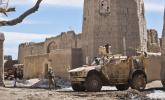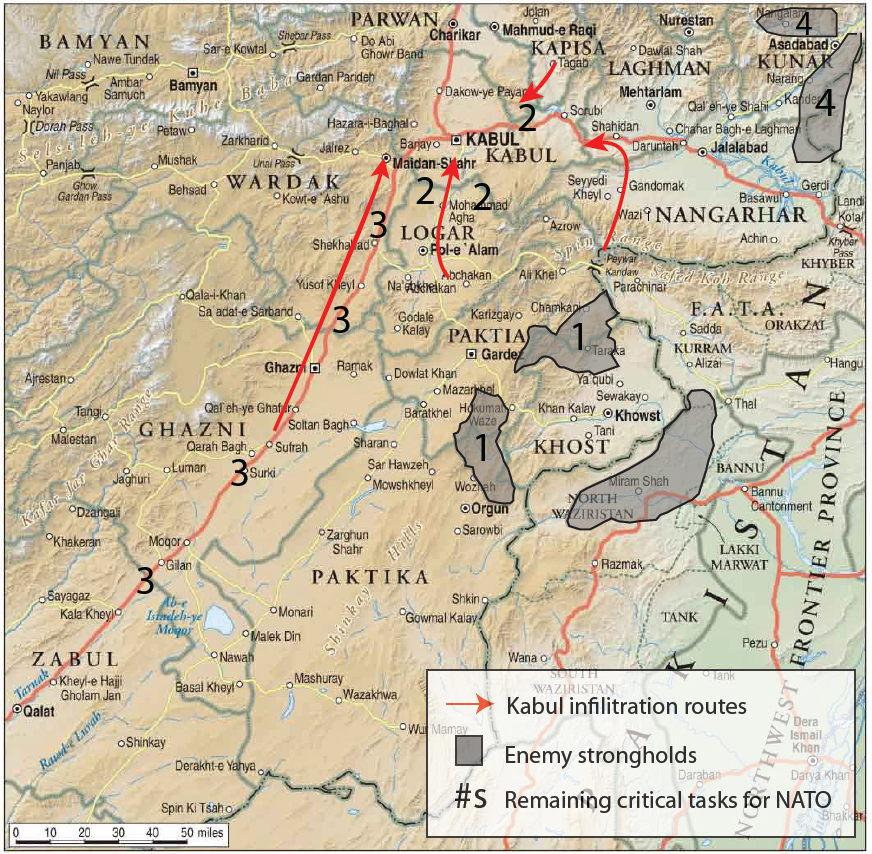 |
 |
Fact Sheet: The Fight for Eastern Afghanistan

Download Fact Sheet: The Fight for Eastern Afghanistan
by Isaac Hock
Security gains made by the addition of U.S. “surge” forces in southern Afghanistan have denied the Taliban its historical safe havens in Kandahar and Helmand. The campaign in Afghanistan must now focus on the East, which received few surge troops. The provinces surrounding Kabul are strategically important for controlling the capital and connecting the city with the rest of Afghanistan.
Enemy Composition and Ties with al Qaeda
The enemy groups in Regional Command East are capable, resilient, and diverse. The Haqqani network, the strongest insurgent group in Afghanistan, operates throughout the southeast and maintains strongholds in Khost and Paktia. Increasingly, it has expanded its influence into the areas surrounding Kabul, as well as parts of Ghazni, Logar, and Wardak. The Haqqani network maintains a significant sanctuary in Pakistan’s North Waziristan, where family members and senior commanders direct operations and plan attacks in Kabul. The Haqqani network has strong historical and current operational ties with al Qaeda and other Pakistan-based terrorist organizations, raising concerns about the danger of unchecked Haqqani sanctuaries in eastern Afghanistan and Pakistan. Other groups active in the east include the Quetta Shura Taliban, Hizb-e-Islami, Tehrik-e Taliban Pakistan, Lashkar-e Taiba, and the Islamic Movement of Uzbekistan. There is also a small al-Qaeda presence in Kunar and Nuristan.
Force Requirements
The fight in the east will require maintaining the current levels of U.S. and Coalition conventional ground forces, with some addition of forces, for at least another two fighting seasons. Simply put, Afghan forces cannot yet accomplish these critical tasks. The Haqqani network and the other groups operating in the east are the most capable and resilient insurgent groups, and Afghan forces will be unable to defeat the Haqqani network on their own. They will require intelligence, surveillance, and reconnaissance capabilities provided by U.S. forces. And U.S. forces alone can bring sufficient lift (helicopters) and the best practices of combined arms combat, integrating infantry, air power, artillery, and maneuver. Few of America’s allies have these sophisticated capabilities, and the Afghans will not gain them any time soon. Special operation forces alone cannot tackle these challenges. While raiding and disrupting insurgent activity will be a necessary part of the strategy, only clearing and holding insurgent strongholds with conventional ground forces and transitioning a stable situation to a capable Afghan force will produce security gains in the east. Furthermore, the Afghan National Security Forces will need replenishment and expansion of personnel in order to meet even the reduced threat they will face if combined American and Afghan operations in 2012 are successful.

The Four Critical Tasks
Task 1: Dismantle Haqqani strongholds in Khost and Paktia, while disrupting Haqqani infiltration. The Haqqani network poses a severe threat to Coalition and government forces throughout areas south of Kabul.
Task 2: Maintain and expand the Kabul “security bubble” while checking Haqqani expansion in the areas around Kabul. Coalition forces have made significant progress in securing the capital, but reducing spectacular attacks in the city requires expanding the security bubble into outlying districts in Kabul province and parts of the surrounding provinces. To facilitate attacks in Kabul, the Haqqani network has steadily expanded its influence in surrounding areas of Logar, Wardak, Kapisa, and Laghman. Securing the city will require rolling back this expansion.
Task 3: Link the relatively secure areas of Kabul and Kandahar City via Highway 1. To link Kabul with southern Afghanistan, Coalition forces must secure the districts along the highway through Wardak and Ghazni. Over the past two years, insurgent groups have expanded their influence in key districts along the highway; although they are not able to sever the road between Kabul and the south, they have hindered movement along the highway and exerted influence along many of the key secondary routes in the region. Securing this vital route requires controlling not only the road but the surrounding population and terrain.
Task 4: Monitor and disrupt al-Qaeda and its affiliates in Kunar and Nuristan while defeating the Pakistani groups operating in the region. Al-Qaeda maintains a small but significant presence in the mountainous interior of Kunar and Nuristan. At the same time, a significant influx of Pakistani militant groups over the past two years has disrupted security in these provinces. There is no immediate threat of al-Qaeda reestablishing sanctuaries and training camps in Kunar, and the Pakistani Taliban appears equally interested in re-infiltrating into Pakistan to conduct attacks. However, the extremely mountainous terrain and the strength of the insurgency in Kunar preclude Afghan forces from tackling these missions. Yet drones and special operations raids alone—without corresponding conventional ground forces conducting clearing operations and collecting reliable intelligence—are unlikely to defeat these threats; an enduring presence, therefore, is necessary to monitor and disrupt al-Qaeda and check Pakistani Taliban activities.